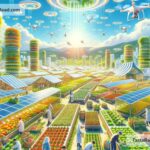The Future of Food and Regenerative Innovation: A Hopeful Path Forward
Food is the heart of our lives. It provides energy, keeps us healthy, and brings people together. But as the world changes, so too does how we grow, produce, and eat food. Climate change, population growth, and soil degradation are putting pressure on our food systems. The question is: how can we feed the world in the future while taking care of our planet? The answer may lie in regenerative innovation.
What is Regenerative Innovation?
Regenerative innovation is about creating solutions that restore, rebuild, and rejuvenate natural systems rather than depleting them. It’s not just about reducing harm — it’s about making things better. In the context of food, it aims to produce food in a way that improves soil health, supports biodiversity, reduces pollution, and helps communities thrive.
Instead of using methods that harm the planet, regenerative practices work with nature. Think of it as a “give-and-take” relationship, where we give as much as we take. Regenerative agriculture is one of the most prominent examples, but the idea goes beyond farming, influencing food packaging, supply chains, and even what we eat.
Why Do We Need a New Approach to Food?
Our current way of producing food has some serious problems. Industrial farming, which is focused on large-scale monoculture crops and heavy chemical use, harms the environment. For example, industrial farming depletes soil nutrients, causing erosion and reducing the quality of land over time. It also contributes to greenhouse gas emissions and relies heavily on fossil fuels for fertilizers, pesticides, and machinery.
At the same time, the world’s population is growing. By 2050, there will be nearly 10 billion people on the planet, and we’ll need to produce more food than ever before to feed everyone. This means we must rethink how we grow food without increasing environmental damage.
Additionally, there is a growing awareness of the need for healthier diets. Poor nutrition and highly processed foods have led to widespread health problems like obesity, diabetes, and heart disease. The way forward is to create food systems that not only nourish people but also contribute positively to the planet.
Regenerative Agriculture: Working with Nature
One promising solution is regenerative agriculture. This method focuses on improving the health of the soil, which is one of the planet’s most vital resources. Healthy soil is full of life — including insects, fungi, and microorganisms — that help plants grow and store carbon from the atmosphere. Regenerative practices turn lifeless dirt into rich, living soil that produces better crops and combats climate change.
Some key regenerative farming techniques include:
-
Cover Crops: Farmers plant crops like clover or rye during the off-season to protect the soil from erosion and improve its health.
-
Crop Rotation: Rotating crops instead of growing the same plants year after year can prevent disease in the soil and keep nutrients balanced.
-
Reducing Tillage: Plowing and digging can disrupt soil health. No-till farming keeps the soil intact and lets nature do its work.
-
Agroforestry: Mixing trees with crops or livestock improves biodiversity and creates more resilient ecosystems.
Technology as a Regenerative Tool
Technology is also helping bring innovation to food in exciting ways. For example, vertical farming — where crops are grown indoors in stacked layers — uses fewer resources and produces fresh food in cities. Drones and robots are being used to monitor crops with precision, reducing waste and minimizing harmful chemicals. Smart irrigation systems ensure water is used efficiently.
Food-tech companies are working on lab-grown meats, plant-based protein alternatives, and climate-resilient crops to meet the challenges of tomorrow. Imagine eating a burger that tastes exactly like beef but is made from plants with a smaller environmental footprint!
Packaging and Supply Chains: A Regenerative Approach
Regenerative innovation isn’t just about farming; it looks at the entire food journey, from farm to table. One big area of concern is food packaging. Plastic waste pollutes oceans and damages ecosystems. Companies are working on biodegradable, compostable, and reusable packaging options to reduce waste.
Supply chains are another area of opportunity. Local food systems can shorten the distance from farm to consumer, reducing carbon emissions tied to transportation. By connecting farmers directly to their communities, we can also make food systems more resilient and equitable.
Changing the Way We Eat
Regenerative innovation isn’t only about technology or farming practices — it’s also about changing how we eat. A shift toward more plant-based diets can have a huge impact on the planet. Producing meat uses vast amounts of land, water, and energy. By eating more plants, legumes, and alternative proteins, we can promote sustainability on a broad scale.
Governments, companies, and individuals all have a role to play in supporting these changes. For example, governments can incentivize regenerative farming practices through subsidies or grants, while companies can lead by creating eco-friendly products. As individuals, we can support local farmers, reduce food waste, and make conscious choices about what we put on our plates.
A Hopeful Future
While challenges lie ahead, the future of food has the potential to be bright. Regenerative innovation offers hope that we can create food systems that nourish both people and the planet. By using smarter technologies, listening to nature, and changing the way we grow and eat, we can create a future where food is abundant, healthy, and sustainable.
The journey toward regenerative food systems has already begun. Every step we take toward innovation and renewal pushes us closer to a more hopeful, connected, and sustainable world.


